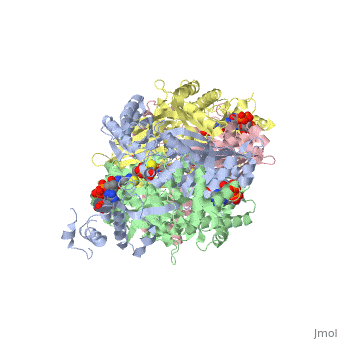Sandbox Reserved 490
From Proteopedia
| This Sandbox is Reserved from 13/03/2012, through 01/06/2012 for use in the course "Proteins and Molecular Mechanisms" taught by Robert B. Rose at the North Carolina State University, Raleigh, NC USA. This reservation includes Sandbox Reserved 451 through Sandbox Reserved 500. | ||||||||||||||||||
To get started:
More help: Help:Editing For more help, look at this link: http://www.proteopedia.org/wiki/index.php/Help:Getting_Started_in_Proteopedia Estrogen ReceptorIntroductionEstrogen receptors (ER) belong to the super family of nuclear receptor proteins (NRP). Nuclear receptor proteins are a diverse group of proteins located in the nucleus. These proteins bind to specific ligands and undergo conformational changes, whereby they can then act as transcription factors to up-regulate or down-regulate certain genes. Nuclear hormone receptors (NHR) are a subgroup of NRPs that have hormone ligands. Estrogen receptors are nuclear hormone receptors whose ligand is estrogen.[1] NRPs are found only in animals.[2] There are two types of estrogen receptors: estrogen receptor-α and estrogen receptor-β. There has been much research done on both ERalpha and ERbeta, and it is still unclear exactly how each functions. However, like all NRPs, the ER proteins have a highly conserved DNA-binding domain, a specific ligand-binding domain, and a highly variable N-terminus region. In ER proteins, the ligand-binding domain is located near the C-terminal region of the protein. The ligand-binding domain of ERalpha and ERbeta are similar. Both ERalpha and ERbeta bind estrogen at the ligand-binding domain. Once bound, the mechanism of transcriptional regulation is dependent upon what co-factors and other signalling molecules are present in the cell.[3] Estrogen and estrogen receptor proteins are known to have a wide variety of functions in multiple different tissue types. It is commonly known that estrogen acts as a morphogen, turning on genes that regulate sex differentiation and development. However, estrogen also plays an important role in other systems, such as the skeletal and cardiovascular systems. The specific genes that are regulated by estrogen is influenced by what other compounds are in the cell. That is, the array of molecules in cardiovascular tissue is different from that of skeletal tissue, and thus the action of the estrogen receptors, once bound to estrogen, are tissue-specific. [4] The function of estrogen receptors has played a key role in the development of treatment strategies for many diseases, most notably breast cancer. The suppression of ER activity in cancerous breast tissue, particularly ERalpha, has been an effective hormonal treatment of breast cancer for decades. Other cancers that are strongly correlated with estrogen and estrogen receptor activity are ovarian cancer, colon cancer, prostate cancer, and endometrial cancer. Increased ER activity in the skeletal system has been an effective treatment for osteoporosis. The symptoms of neurodegenerative diseases such as stroke, Parkinson's, and Alzheimer's, and cardiovascular diseases have been shown to be alleviated by estrogen and increased estrogen receptor activity.[5] StructureEstrogen receptors have two important structural components: the DNA-binding domain and the ligand-binding domain. DNA-Binding domain ==Estrogen Receptor DBD==
|
||||||||||||||||||

